General description of offense within the game of basketball
Offense is a system within the game of basketball that utilizes various fundamental components such as individual player skills as well as team strategies and tactics to create scoring opportunities near the basket or around perimeter areas of the court against an opposing defense.
Court areas to consider for basketball offense
Primary court areas that players typically occupy
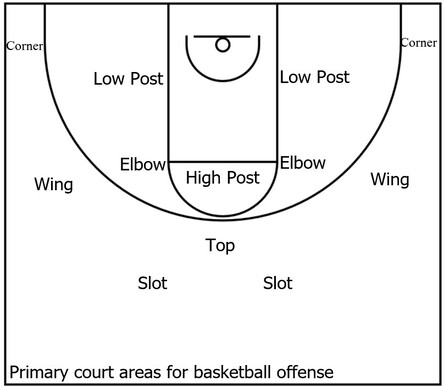
The primary court areas that players typically occupy while executing basketball offense comprise the top, the wings, the corners, the slots, the high post including the elbows, and the low posts.
The example diagram above showcases the main areas of the court that could be occupied or filled by any individual player on offense.
Also, notice that each court area is spread apart by a certain distance from other court areas.
It is not drawn to scale on the diagram but the distance between each adjacent court area is at least 10 to 12 feet apart or more.
If each offensive player on the team occupies one of those areas while spread apart from other teammates, then that would be representative of good spacing, which is a key principle to consider when executing basketball offense.
Conversely, if offensive players are less than approximately 10 to 12 feet apart, then that would be usually representative of bad spacing as the players are too close together.
What’s more, bad spacing also makes it easier for the defensive team to mitigate or completely stop offensive production, and more specifically, offensive scoring opportunities.
Moreover, when offensive players are able to understand and apply the fundamentals of good spacing on the court, this will help them to efficiently perform their respective basketball skills to help the team score points and ultimately win the game.
In addition to that, it is generally more challenging for the opposing defensive team to limit or prevent the aforementioned basketball skills when offensive players implement good floor spacing.
Furthermore, the adjacent information below contains brief descriptions in relation to each relevant area of the court.
Top
The top, sometimes referred to as top of the key or point, is the general area located behind the three-point line in the middle of the offensive team’s frontcourt.
Wings
The wings consists of the court areas behind the three-point line that are adjacent to the nearest sideline, which is generally at or above the free throw line extended, an imaginary line expanded from the edges of the free throw line.
Corners
The corners comprise the areas behind the three-point line that are in the general vicinity of a sideline, which is the vertical boundary line of the court in addition to its adjoining baseline, which is the horizontal boundary line behind the basket.
High post + Elbows
The high post is the general area that covers the free throw line from one edge to the other as well as the adjacent area that is between the free throw line and the top of the three-point line.
Furthermore, the edges of the free throw line are typically known as the high post elbows or simply, the elbow areas of the court.
Slots
The slots, sometimes referred to as the lane line extended areas, are specific spots above the three-point line between the top and the wings.
Low posts
The low post areas are slightly above the basket and just outside of the lane lines, which are borders on both sides of the basket.
Secondary court areas that players might occupy
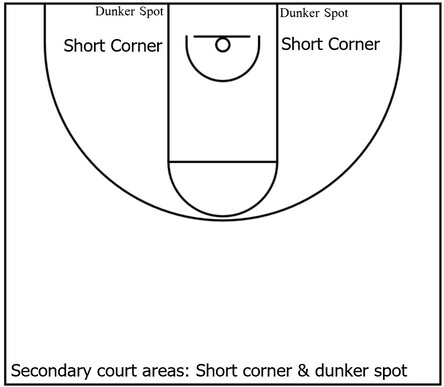
There are also secondary court areas that players could potentially occupy within special instances or while executing specific basketball offensive strategies.
These areas are generally known as the short corners and the dunker spot.
The diagram above showcases these secondary areas while the subsection below gives brief details about them.
Short corners
The short corners are the general areas inside of the three-point line that are between the corner and the basket.
The short corners are also slightly below the low post areas and adjacent to the baseline.
These areas are typically used within certain offensive strategies to help the team create scoring opportunities against the defense.
Dunker spot
The dunker spot is an area of the basketball court that is adjacent to and slightly below the short corner as well as the low post area near the baseline and lane line.
The dunker spot is usually filled at certain situations within a basketball offensive strategy by a player who is adept at scoring around the basket.
This can be an even greater factor if that same player has the ability to dunk the basket, hence the name of the court area. However, it is not an absolute requirement for a player to be able to dunk to fill the dunker spot.
Additional court areas to consider
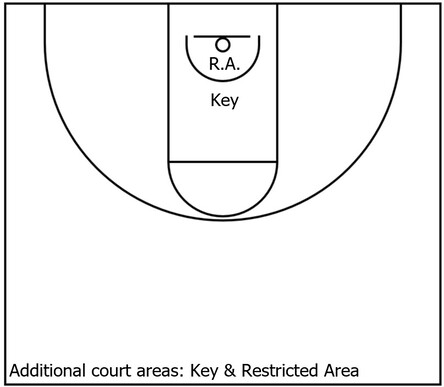
Alongside the primary court areas that players would typically fill alongside the secondary court areas that players may occupy in certain cases, there are additional court areas that should be considered while executing basketball offense.
These particular sub areas are generally known as the key and the restricted area.
The diagram above showcases the key as well as an abbreviated label denoted as R.A. in reference to the restricted area.
There is also basic information in the next subsection below that briefly describes each of these sub-areas.
Key
The key, sometimes referred to as the lane or the paint, is the boxed area below the high post/free throw line that also contains the basket.
It is called the paint as well because that part of the court could include a certain color, typically based on the home team’s jersey color.
However, in reference to any of the diagrams within this web page, a specific “team” color is not shown. Instead, the diagrams within this web page simply show a white background to represent the “paint”, also once again, known as the key.
Moreover, offensive players will usually not occupy the key, except for a very limited time, such as to quickly score around the basket after already having possession of the basketball or via receiving it from a teammate.
Otherwise, if offensive players attempt to remain in the key for too long, sometimes called “camping in the lane”, then that could potentially lead to a violation of the three-second rule.
This particular rule, which is sometimes referred to as “3 in the key” generally gives an offensive player no more than three consecutive seconds to remain in the key.
Nevertheless, an offensive player is allowed to enter and exit the key as many times as desired. However, that same player typically cannot “camp” in that area for more than three seconds as mentioned earlier.
Restricted area
The restricted area is a certain section within the key, denoted as a small arc around the basket.
Depending on the level of competition and/or locality, the restricted area could be implemented within professional or non-professional leagues or organizations such as the NBA, WNBA, FIBA, or NCAA among others.
The primary purpose of the restricted area is to hinder or “restrict” certain defenders, generally known as secondary or helping defenders, from establishing an initial legal guarding position within that same area.
In other words, with the restricted area on the court, certain defensive players are discouraged from attempting to draw offensive fouls, particularly a charging foul, on players who were in the process of driving to the basket and/or attempting a layup/dunk.
Primary fundamental skills for basketball offense
The primary fundamental skills for basketball offense consists of cutting, dribbling, passing, screening, and shooting. Each player should develop a solid foundation and basic understanding of these skills.
It should also be noted that certain players might become more proficient at specific skills than other players. However, as long as each player is able to grasp the essential concepts of the primary skills, it will generally not be as challenging for the players to execute any particular basketball offensive plan.
The next few subsections cover the fundamental skills in more detail.
Furthermore, any players that are shown on any of the diagrams within the next few subsections do not necessarily have a particular role on the court.
Instead, for demonstrative purposes, the players are simply indicated by numbers such as 1 and 2.
Cutting
Basketball cutting is an offensive skill that occurs when a player without possession of the ball utilizes a specific action to move from one location of the court to another area with the primary purpose of creating space and getting open from a defender.
Additionally cutting is an important concept to consider because if an offensive player stands in one spot on the court, then it will be easier for a defender to guard and contain that stationary offensive player.
Moreover, if offensive players who are not in possession of the ball do not cut at all and remain in one spot on the court indefinitely, then it would be much more challenging to score points, which would be detrimental to the offensive team as a whole.
What’s more, if cutting is implemented within a team’s offensive strategy in general, then that could present greater difficulty for the defensive team to effectively stop two actions at the same time.
In other words, the defensive team will not be able to efficiently guard the player with the ball as well as one or more off-ball cutters.
Eventually, the defensive team would have to decide if they would want to focus more on the ball itself or prioritize off-ball cutters.
Either way, off-ball cutting potentially presents a challenge for the defensive team to adequately guard the ball as well as the other players who are not currently in possession of the ball.
The next subsection demonstrates a few different types of basketball cuts that could be performed by a player to get open within their team’s respective offensive scheme.
Also, once again, as stated earlier, the offensive players within this next section in addition to subsequent subsections are only indicated by a number such as 1 or 2.
Backdoor cut
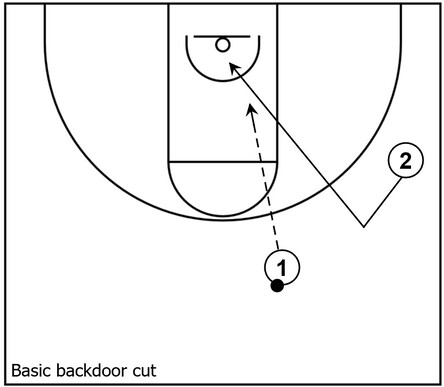
The backdoor cut occurs when a player without possession of the basketball seeks to get open, typically by way of an initial quick step towards a player with the ball, followed by an immediate cut to the basket.
The diagram above shows an example of a basic backdoor cut involving two players.
Prior to starting the simple action, 1 is located near the right slot while in possession of the basketball, represented by the black dot and 2 fills the right wing.
Essentially, 2 takes a step towards 1 and then immediately cuts to the basket, denoted by the solid arrow.
Next, 1 passes the ball, shown via the dotted arrow, with 2 as the recipient. Afterwards 2 has an opportunity to score around the basket.
Dive cut
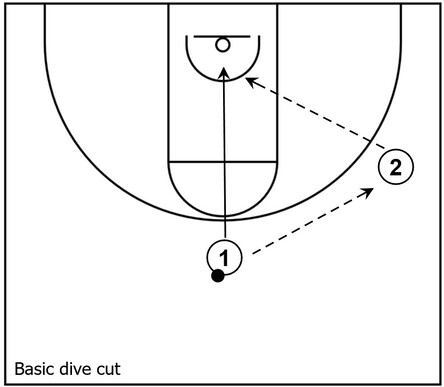
The dive cut, sometimes referred to as the straight cut, occurs when an offensive player cuts directly to the basket from their current location on the court.
On the diagram above, prior to the action, players 1 and 2 are located at the top and right side wing respectively.
To start, 2 receives the ball from 1 who then swiftly performs a dive cut directly to the basket.
Afterwards, 1 receives the ball from 2 and can score near the basket.
It should also be mentioned that this particular simple sequence can be considered give and go action because player 1 gives the ball to player 2 and immediately goes to the basket.
Iverson cut
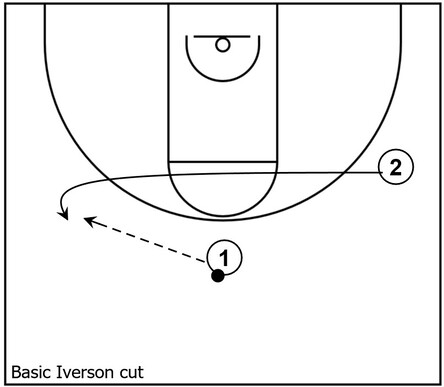
The Iverson cut occurs when an offensive player is initially on one side of the court, usually near a wing area, and then cuts across to the opposite wing area, typically by way of the high post elbows.
In addition to that, as a side note, the Iverson cut is named after and popularized by former professional NBA player and Hall of Famer, Allen Iverson.
On the adjacent diagram above, 2 performs an Iverson cut by moving across the two high post elbow areas to receive the ball from 1.
L-Cut
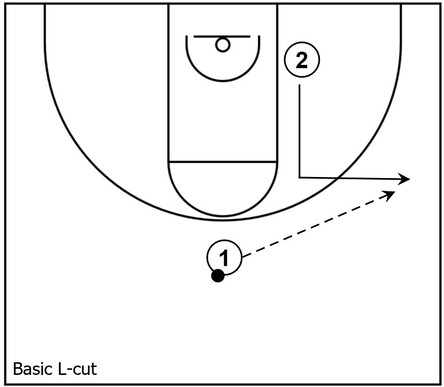
The L-cut occurs when an offensive player, initially located near the low post area, creates movement on the court in the shape of the letter L by cutting up towards the mid-post or high post and then immediately out towards the wing area.
On the adjacent diagram above, 2 executes an L-cut by initially starting near the right side low post area before popping out towards the right side wing.
Afterwards, 2 receives the ball from 1, which could then lead to some other offensive action.
V cut
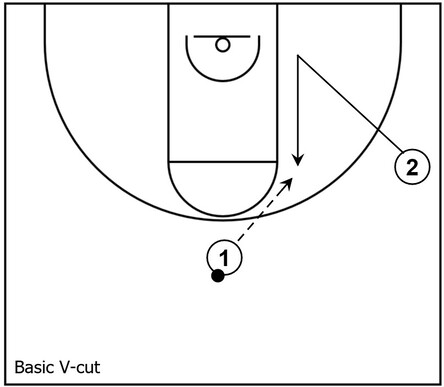
The V-cut occurs when an offensive player, initially located near a perimeter area such as the wing, creates movement on the court in the shape of the letter V by cutting away from the ball, usually towards the basket, and then cutting back towards the general direction of the ball while still near a perimeter area.
On the diagram above, 1 is initially at the top in possession of the basketball while 2 is located near the right side wing.
Next, 2 performs the V-cut by initially cutting towards the basket from the right side wing and then cutting back towards the ball near the right side high post elbow area.
From there, 2 receives the ball from 1 and that could lead to some other offensive action afterwards.
Dribbling
Basketball dribbling is another primary basic skill and it occurs when an offensive player in possession of the basketball bounces it to the floor at least one time before grasping it with both hands or palming it, especially underneath one hand, which would indicate the end of the dribbling sequence.
Simple diagram examples of dribbling
The following simple examples show what dribbling looks like on a basketball diagram.
Basic full court dribbling action
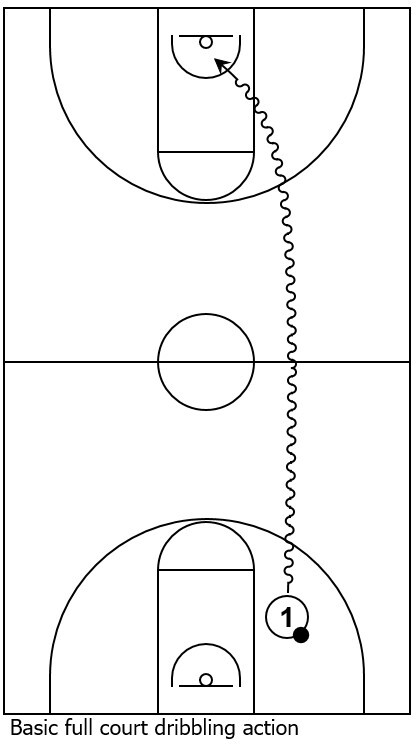
On the diagram, the offensive player, denoted by the number 1 dribbles the ball, represented by the wavy arrow, towards the basket going from one end, which is the backcourt to the other end, which is the frontcourt.
Basic half court dribbling action
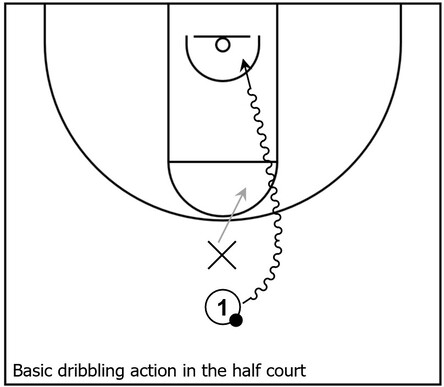
For this simple example, the offensive player, indicated by the number 1, has possession of the basketball in the half court, which is also the frontcourt, and is currently being guarded by a generic on-ball defender, represented by the letter X.
For demonstrative purposes, 1 is able to easily blow by X and dribble towards the basket while X chases behind, shown via the gray arrow.
General importance of dribbling
Dribbling is generally important because it can be utilized to produce scoring opportunities, primarily by advancing the basketball towards the rim and/or by creating separation between the offensive player in possession of the ball and the on-ball defender.
In other words, when an offensive player dribbles with a purpose to attack the rim and/or to establish a certain amount of space between themselves and the on-ball defender, then that same player could eventually use other skills, particularly passing or shooting, which could result in additional scoring opportunities.
Furthermore, dribbling is possibly a better option to consider when a teammate is not open to receive the ball via a pass and/or the offensive player in possession of the ball cannot shoot it themselves, particularly by way of an open, high quality mid-range or three-point shot.
Put another way, an offensive player should consider dribbling the basketball instead of taking an ill-advised highly contested shot or throwing a bad pass, which would potentially lead to a turnover.
Basic dribbling instructions to consider
These are simple instructions that players could consider prior in relation to dribbling the basketball.
Athletic stance
Prior to dribbling, an offensive player should initially get into an athletic stance, which consists of having feet approximately shoulder width apart, knees slightly bent, and back straightened.
The athletic stance also helps the offensive player stay on balance to dribble effectively, particularly against potential on-ball defensive pressure.
Head up, eyes forward
Upon dribbling the basketball or even prior to dribbling, the offensive player should have their head up and their eyes forward.
This helps the player to survey the entire court and see offensive teammates as well as defenders of the opposing team.
Furthermore, when an offensive player keeps their head up and eyes forward while dribbling, that could lead to one or more scoring opportunities for themselves or other teammates.
Wrist snap
Upon dribbling the basketball, the offensive player should snap their wrist, which gives the ball velocity.
Additionally, by snapping the wrist, the offensive player will typically have better and more consistent control over the ball while dribbling it.
Finger pad control
The offensive player should generally use the finger pads of their hand while dribbling it, which could also result in greater control over the ball as well.
In other words, if an offensive player were to attempt to dribble directly with the palm of their hand and/or without their finger pads in general, then the ball would usually be harder to control.
As a result, the offensive player could potentially lose possession of the ball, which may lead to an unnecessary and undesirable turnover.
Elbow extension
The offensive player should extend the elbow as much as possible when dribbling the basketball.
This also generally leads to better control control and it typically gives the player an opportunity to execute more efficient dribbling actions, especially while moving with the ball.
Low dribble when necessary
In general, an offensive player should try to dribble the ball low when possible or necessary, essentially below the waist area or even below the knees, especially against on-ball defensive pressure.
What’s more, when an offensive player keeps the ball lower to ground while dribbling it, that could also result in better ball control.
Additionally, a low dribble is typically much more difficult for an on-ball defender to steal, especially when compared with a higher dribble.
Ball protection
If an on-ball defender is applying an above average amount of defensive pressure, then the offensive player should turn their body sideways at an angle to protect the ball and keep it away from that same on-ball defender.
Moreover, while dribbling with one particular hand and arm, the offensive player can bend their opposite elbow and place their opposite forearm near the side of their body that is opposite the ball (or closest to the on-ball defender) as another barrier of protection.
However, it should be mentioned that the offensive player cannot extend their non-dribbling forearm out towards the defender, especially to push the defender away.
If that happened, the offensive player could be potentially assessed an offensive foul by a referee due to creating illegal contact with the opposing player.
Main types dribbling moves
Main types of dribbling moves that offensive players should strongly consider learning and potentially mastering include the standard crossover dribble, between the legs dribble, and behind the back dribble among others.
Crossover dribble
The crossover dribble occurs when an offensive player initially dribbles the ball with one hand towards the adjacent area that is in front of them and afterwards, that same player catches the ball with the opposite hand.
This particular dribbling move is potentially effective because it could help an offensive player create space and separation from an on-ball defender, primarily to attack the rim or take an open jump shot.
Between the legs dribble
Between the legs dribble occurs when an offensive player dribbles the basketball with one particular hand between their legs and afterwards, that same player catches the ball with their opposite hand.
Moreover, there are two primary variations of between the legs dribble action.
In the first variation, which is also the standard form, an offensive player dribbles the ball between their legs with one particular hand as it is in front of them, and afterwards, that same player catches the ball once it is near the leg that is opposite the initial dribbling hand.
In the second variation, which is generally referred to as a reverse between the legs dribble, an offensive player dribbles the ball between their legs with one particular hand as it is behind them, and afterwards, that same player catches the ball once it is near the leg that is opposite the initial dribbling hand.
What’s more, it is feasible for an offensive player to dribble the ball between their legs while remaining stationary in one spot or while moving up and down the court.
Behind the back dribble
Behind the back dribble features action of an offensive player dribbling the basketball with one particular hand behind their back, as the name implies, and afterwards, catching the ball with their opposite hand.
behind the back dribbling is generally most effective when it is used as a counter move to certain on-ball defensive actions.
For example, let’s say that an offensive player is dribbling the ball with their right hand and then an on-ball defender attempts to steal it.
To counter that, the offensive player could dribble the ball behind their back into their left hand, which would also result in the on-ball defender being out of proper position.
In and out dribble
With the in and out dribble move, an offensive player dribbles the ball with one hand across the frontal area of their body while executing a jab step with the opposite foot at the same time.
Furthermore, the offensive player will keep the ball in the same hand while performing the dribbling move.
Hesitation dribble
The hesitation dribble consists of action that occurs when an offensive player initially dribbles the ball one or more times utilizing a certain rhythm or tempo followed by a subsequent dribble that is purposely delayed to momentarily freeze a defender in their stance.
Spin move
When performing a spin move, the offensive player dribbles the ball while simultaneously spinning in a circular fashion away from a defender to create separation for a potential scoring opportunity or to simply alleviate defensive pressure.
Stutter step dribble
In reference to the stutter step dribble move, an offensive player dribbles the basketball while simultaneously executing a series of short and quick steps, especially against a defender, ultimately to attack the basket or take a jump shot.
Passing
Passing is another offensive skill that occurs when a player in current possession of the ball throws it to a teammate with the typical objective of creating scoring opportunities near the basket or around the perimeter areas of the court.
General importance of passing
In addition, passing is essential for players to learn because if players are not able to make accurate and/or timely passes, then the offense will most likely become stagnant.
When that occurs, it will most certainly become very difficult for the offensive team to generate high percentage shots.
What’s more, little to no passing, especially without ball reversal, causes the defenders to remain stationary, which is a benefit to the defensive team but a detriment to the offensive team.
On the other hand, a team that constantly executes ball movement will usually break down the defense. Once a defensive breakdown occurs, the offensive team will gain access to high quality shots either near the rim or around perimeter areas.
Passing is also important because it promotes good teamwork, it can improve team chemistry, it could potentially assist with overall skill development.
In terms of promoting good teamwork, if an individual player were to hold possession of the ball most or all of the time, then that would rarely, if ever, lead to sustainable success for the team as a whole.
In other words, the game of basketball is a team sport so this effectively means that each member of the team should be able to give a contribution, regardless if it is small or large.
Passing the basketball is a simple way to achieve that contribution. When one teammate passes the ball to another, it could help both players as well as the entire team in general.
In relation to boosting team chemistry, passing generally helps the players to build trust and at the same time, the players will be able to learn each other’s strengths and weaknesses.
In reference to skill development assistance, passing could help the player executing the pass as well as the player receiving the ball.
For example, let’s say player 1 has possession of the ball and player 2 cuts to the basket looking to get open and receive the ball.
From there, let’s say that player 1 throws the ball and player 2 catches it, which then leads to a scoring opportunity.
In this basic scenario, player 1 increased their passing skills by making a good pass to their teammate and at the same time, player 2 increased their cutting skills by performing a good cut to get open.
Even if the skill development only increases minimally in that instance, consistently performing skilled actions such as those could help players become better over time.
Basic types of passes
There are different types of passes that basketball players could execute including the more common basic passes typically known as the chest pass, bounce pass, and overhead pass.
Chest pass
The chest pass occurs when a player in current possession of the basketball throws it with two hands from their own chest area towards the chest area of a teammate.
The chest pass is one of the most essential passes that players should learn because it is a simple way of creating ball movement, which could lead to scoring opportunities.
Bounce pass
The bounce pass happens when a player in possession of the ball throws it with a sufficient amount of strength and at a certain angle to the floor so that a teammate can receive it, preferably near their chest or waist area.
The bounce pass is particularly useful when one or more defenders’ hands are high and because of that, it could become difficult to throw an effective air pass such as the chest pass without the possibility of a defensive deflection or interception, which could lead to a turnover.
Overhead pass
The overhead pass occurs when a player in current possession of the basketball places it over their head before throwing it with two hands towards a teammate that is able to receive it.
The overhead pass could be considered if the potential receiver of the pass is a significant distance from the passer.
Basic passing drill
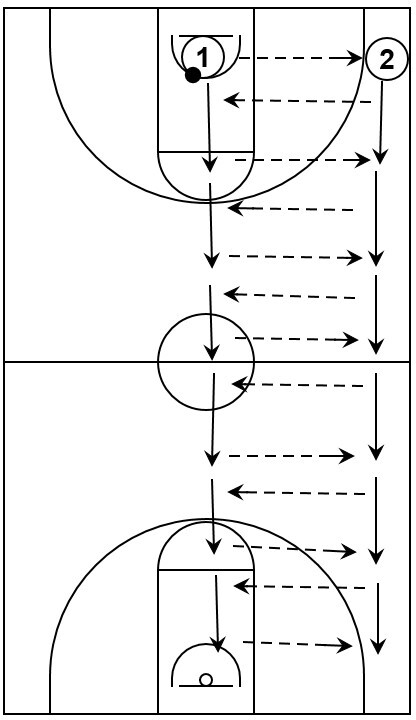
This drill requires at least two players who will become partners but more pairs could be added as necessary.
Essentially, for this case, players 1 and 2 begin on one side of the court near a baseline facing each other.
Also, for the example, player 1 starts under the basket in the lane with possession of the ball while player 2 starts behind the three-point line in the corner.
However, it is possible for player 1 to space out even more across the lane, especially when throwing the overhead pass.
From that point, the players can work on throwing the basic passes to each other.
For example, let’s say that the players want to practice throwing the chest pass.
So, at the start of the drill, player 1 throws a chest pass with 2 as the receiver while sliding down the court.
Moreover, player 2 begins sliding down the court mirroring player 1’s movement while catching the ball.
Afterwards, player 2 throws a chest pass back to player 1 while both players continue sliding down the court, remaining in sync of each other’s movement.
Player 1 throws another chest pass back to player 2 while sliding and this pattern continues until both players reach the opposite baseline.
From there, the two players could start the drill again and throw the bounce pass to each other or the overhead pass to each other.
Additionally, the players can even mix in different passes as well. For example, player 1 could throw the chest pass while player 2 throws the bounce pass.
As another example, player 1 could throw the overhead pass while player 2 throws the chest pass.
Screening
Basketball Screening is yet another foundational offensive skill that players should learn and utilize.
Essentially, there are various types of basketball screens that could consist of the on-ball screen typically used in pick and roll action or off-ball screens such as the down screen or cross screen.
With either type of the screen, the offense would be able to limit the effectiveness of the defense and potentially create scoring opportunities on the perimeter or close to the basket.
Furthermore, offensive sequences with little to no screening would inevitably become stagnant as the defense could basically contain their respective assignments or receive help from another teammate in the event of dribble penetration.
Additionally, screens could help create mismatches and if that occurs, then this could bring forth another possible advantage for the offense.
For example, if a post player on defense becomes matched up with an offensive guard near the perimeter, then the guard could potentially gain an advantage by executing a speedy dribble move against the bigger and/or slower post defender.
In similar fashion, if a guard on defense becomes matched up with an offensive post player near the low post block, then the post player could possibly gain the advantage by using size and/or strength to score near the basket with a low post move.
Also, players should be mindful not to commit an illegal screen that generally occurs when an offensive player setting a screen does not stay within their vertical plane or the offensive player setting the screen does not allow a defender, who would be the target of the screen, enough time and/or distance to avoid the screen.
Furthermore, in the case of an on-ball screen, also called a pick, if the ball handler dribbles towards the screener and the defender makes contact with the screen before the screener fully established a stationary position, then the screener would still be called for an illegal screen.
Also, in the case of an off-ball screen such as a down screen, if the defender attempts to quickly avoid the screen prior to the moment of contact, then the screener could technically move to re-establish the screen as long as the movement occurs before the moment of contact.
However, according to Rule 10, Section XIV of the Official NBA rule book, a screener cannot step out of bounds to set a screen on a defender, particularly on the baseline in the frontcourt.
For example, if a screener is setting a pin down screen near the baseline but the defender attempts to avoid the screen by stepping out of bounds, then the screener cannot step out of bounds to re-establish the screen, even if the screen occurs before the moment of contact. In that instance, it would be considered a violation.
Related: Off Ball Screens – NBA Video Rulebook
Shooting
Basketball shooting is arguably the most important offensive skill to consider because if a team does not shoot or cannot shoot, then that team will not score many points.
Additionally, by implementing the other basic skills of cutting, dribbling, passing, and screening, an offensive team could generate the most efficient shots.
Furthermore, shooting is important against zone defenses that seek to take away scoring options around the basket as well as limit the effectiveness of offensive-minded post players.
Therefore, it is essential that a team includes at least one or two shooters on the court at all times on offense.
The point of having at least one or two shooters is to give the offense a chance to still score if the defense runs a zone as mentioned previously or if the offensive play breaks down and the team needs a basket such as at the end of the shot clock or at the end of a game’s quarter or half.
However, if a team does happen to have many non-shooters on the roster, then that team should give tremendous effort on defense to make up for the lack of shooting.
The main types of shots a team could take for scoring purposes include layups at the basket, low post shots near the basket, floaters typically in the key near the dotted half-circle, mid-range shots inside the three-point line, three-point shots, and free throws.
Most of the time, players on offense should try to make layups, floaters or get the ball inside to the post players whenever possible.
However, the defense will usually try to take away those easy scoring options so it is very important that teams can make mid-range shots or three-pointers when those options become necessary.
Furthermore, in terms of shooting, it is important for players to practice free throws as much as possible because free throws can help win games.
Essentially, the repetitions from practicing free throws can help build up muscle memory so when each player steps to the line, they do not think too much or preferably at all about shooting and it becomes more of an automatic process.
Standard player positions for basketball offense
The standard player positions for basketball offense are known as the point guard, shooting guard, small forward, power forward, and center. Also, each position typically has different roles and responsibilities, although some positions could have overlap between them.
Point Guard
The point guard is usually the primary ball handler and play caller that typically initiates the offensive half court set.
Also, the point guard generally possesses an above average basketball IQ, speed, quickness, as well as dribbling, passing, perimeter shooting, and leadership skills.
Furthermore, there are generally two types of point guards : scoring point guards that excel at scoring the ball and facilitator point guards that are good at creating scoring opportunities for teammates.
Additionally, the point guard is typically the smallest player on the court in terms of height but this is not always the case.
Shooting Guard
The shooting guard is generally taller than the point guard but usually, a few inches shorter than the small forward. Additionally, the shooting guard is generally the team’s best outside shooter, especially from three-point range.
Also, the shooting guard could potentially excel at driving to the basket and scoring through contact. Furthermore, the shooting guard typically possesses very good ball handling and dribbling skills for their position.
Small Forward
The small forward is typically taller and/or longer than the shooting guard but generally, a few inches shorter than the power forward. Also, the small forward usually has above average traits in rebounding and defense.
In addition to that, the small forward usually possesses good basketball IQ, dribbling skills, and this player can generally shoot near the perimeter or finish at the rim, similar to the shooting guard.
Power Forward
The power forward is generally taller than the small forward and typically has above average rebounding skills. Also, the power forward could possess an excellent low post skill set that helps them to score around the basket.
Furthermore, the power forward could also have the ability to shoot from the mid-range or three-point range.
Center
The center is typically the tallest player on the court and generally scores around the basket by way of low post moves, dunks, and put-back shots.
Additionally, the center is usually above average at blocking shots and gathering offensive and defensive rebounds.
Furthermore, some centers could also shoot from the mid-range and/or three-point range, possibly increasing their offensive versatility.
Types of basketball offense
The types of basketball offense consist of various categories of offensive formations, patterns, or distinctive systems that also include a common characteristic of creating scoring opportunities to ultimately win basketball games.
The names of the various categories for the different types are generally known as set offense, zone offense, press offense, transition offense, continuity offense, motion offense, and inbound plays.
Set Offense
A set offense features specific plays, also known as set plays, offensive strategies, or quick hitters that are typically designed to create scoring opportunities for the team’s best players.
Additionally, a set offense usually implements a certain offensive formation during the initial phase of the offense.
For example, the box offense strategy, which is also a set offense, starts with one player at the top and four additional players near the low posts and high posts elbows.
When each of the four players near the various posts fill those areas, the formation looks similar to a box, hence its name.
Furthermore, a set offense usually consists of a predetermined path (e.g. get the ball to the best three-point shooters or low post players) but if that path is unsuccessful for whatever reason, then the set generally has to start over again or the team has to implement another set.
Zone Offense
A zone offense consists of one or more offensive strategies formulated to beat one or more types of zone defense.
As an example, the short corner zone offense could be implemented against the 2-3 zone defense by attacking its soft spots, which of course, are the short corners.
Press Offense
A press offense, also referred to as a press break, includes specific plays and formations that are designed to counter against one or more press defenses, particularly in the full court.
Transition Offense
A transition offense, also generally referred to as a fast break, comprises special offensive strategies known as primary break, secondary break, or the numbered fast break.
The main objective of transition offense is to score points quickly and efficiently, particularly during the transition from defense to offense and before the opposing team can protect their own basket, adequately match up, or implement complete defensive formations.
Continuity Offense
A continuity offense incorporates specific patterns of cuts, screens, passes, or dribble actions that are then executed in a continuous manner on both sides of the floor until the offensive team procures the best available shot near the basket or near the perimeter.
Motion Offense
A motion offense is devised of unique offensive strategies that typically consist of certain rules or principles players should follow to generate scoring opportunities near the basket or near the perimeter.
Additionally, many motion offenses can utilize elements of set offenses to produce scoring options for the team’s best players.
However, unlike set offenses, which are generally more rigid, the players involved in a motion offense can usually read the defense and react accordingly.
Furthermore, most motion offenses are also flexible enough to perform similar to continuity offenses as well.
Therefore, if the offensive team is not able to score with the initial actions of the motion offense, then that same team could potentially execute the offensive action once more as a continuity pattern.
Inbound Plays
Inbound plays occur when an offensive player is able to execute a throw-in while standing behind a sideline or baseline.
Moreover, inbound plays typically occur after stoppage of play and they are usually ran for the team’s best players, similar to set offenses. Therefore, inbound plays could be thought of as a sub-type of set play.
Strategies of basketball offense
Strategies of basketball offense are essentially planned, structured actions, styles, or systems implemented by the coaching staff and generally utilized by all five offensive players on the floor to reach the ultimate objective of scoring points.
Additionally, various strategies could be associated with the different types of basketball offense and each strategy could utilize one or more tactics to achieve success.
For example, the Horns offense is a strategy that is associated with the primary set offense type.
It is because the Horns offense uses half court set plays that are typically predetermined to create scoring opportunities for the team’s best players.
As another example, the 5 out motion offense is a strategy that is associated with motion offense as well as continuity offense.
It is because the 5 out motion offense is a read and react system, it consists of certain rules for the players, and it can be implemented as a continuity pattern.
1-4 High Offense
The 1-4 high offense is a basketball offensive strategy that primarily utilizes the high post as well as the wing areas to create scoring opportunities near the basket or near the perimeter, typically with a variety of basketball cuts and/or basketball screens.
The initial formation of the 1-4 high offense consists of an offensive player with the ball at the top, two players near the wing areas, and two players near the high post elbow areas.
1-4 Press Break
The 1-4 press break is a basketball offensive strategy that can be used as a counter against press defenses such as the 1-2-1-1 diamond press, the 2-2-1 press, the 1-2-2 press or a full court man to man press.
2 Out 3 In Motion Offense
The 2 out 3 in motion offense is a basketball offensive strategy that emphasizes ball movement, post split action, and continuity patterns to create scoring opportunities near the basket or near the perimeter.
The formation of the 2 out 3 in motion offense includes two players above (or outside) the free throw line extended area and three players below (or inside) the free throw line extended area.
3 Out 2 In Motion Offense
The 3 out 2 in motion offense is a basketball offensive strategy that seeks to create multiple scoring opportunities through the use of set plays as well as offensive actions such as basketball screens, basketball cuts, continuity patterns and pick and roll options among others.
The formation of the 3 out 2 in motion offense begins with three perimeter players near the tops and wings as well as two players near the low post blocks.
4 Out 1 In Motion Offense
The 4 out 1 in motion offense is a basketball offensive strategy that creates scoring opportunities via a variety of sequences such as basketball cuts, basketball screens, and dribble drive action.
Also, the typical formation of the 4 out 1 in motion offense starts with two players in the slot areas near the top, two players on the wings (or the corners in some instances), and another player near the low post.
5 Out Motion Offense
The 5 out motion offense is a basketball offensive strategy that utilizes the fundamental skills of passing, cutting, and screening as well as continuity patterns to create scoring opportunities, typically near the basket or near the perimeter.
Within the 5 out motion offense, each player should fill one of the perimeter areas of the top, wings, or corners.
Attack and React Offense
The Attack and React offense is a basketball offensive strategy, developed by Andrew Grantz that utilizes the fundamental principles of dribble drive, read and react, and motion offense to create scoring opportunities near the basket or near the perimeter.
The initial formation begins in a wide 4 out 1 in configuration. Two players should fill the slots at the top, two players should fill the corners, and one additional player should fill the low post block on the same side of the ball.
Blocker Mover Offense
The Blocker Mover offense is a basketball offensive strategy developed by Dick Bennett and was utilized in recent years by his son, Tony Bennett, during his time as the head coach for the University of Virginia Cavaliers men’s basketball team.
It typically begins in a 3 out 2 in formation and features two players known as blockers and three players referred to as movers.
The blockers will set screens while the movers will use those screens. The primary screens that are set by the blockers include the pin down screen, flare screen, and sometimes, the on-ball screen.
If the various screening actions are successful, then scoring opportunities could be produced near the perimeter or near the basket.
Box Offense
The box offense is a basketball offensive strategy that utilizes a variety of off-ball and on-ball screens to create scoring opportunities, particularly for the team’s best scorers.
The formation of the box offense is a player at the top, two players near the high posts, and two more players near the low posts.
Circle Offense
The circle offense is a basketball offensive strategy that utilizes cuts and continuity patterns to create scoring opportunities near the basket.
Additionally, the circle offense features five players that should fill the perimeter spots near the top, the wings, and the corners, similar to the standard 5 out motion offense.
Dribble Drive Motion Offense
The Dribble Drive Motion offense is a basketball offensive strategy developed by Vance Walberg that emphasizes spreading the floor and aggressively dribbling into the gaps of the defense to create scoring opportunities near the basket or near the perimeter, particularly behind the three-point line.
Flex Offense
The flex offense is a basketball offensive strategy that creates scoring opportunities near the basket or near the perimeter by way of two types of basketball screens known as the flex screen and the down screen.
Hawk Offense
The Hawk offense is a basketball offensive strategy that utilizes various basketball screens such as a high post screen and stagger screens to create scoring opportunities near the basket or near the perimeter.
Horns Offense
The Horns offense is a basketball offensive strategy that emphasizes spacing to create scoring opportunities near the basket or near the perimeter by way of various actions such as basketball screens and dribble handoffs.
The initial formation of the Horns offense begins with a primary ball handler at the top, two players near the high posts, and two additional players in the corners.
Princeton Offense
The Princeton offense is a basketball offensive strategy that utilizes the fundamental skills of cutting, dribbling, passing, screening, and shooting as well as three unique series of actions known as Chin, Low and Point to create scoring opportunities near the basket or near the perimeter.
Additionally, the Princeton offense typically begins with two guards near the slot areas, two wing players, and one additional player near the high post or low post.
Shuffle Offense
The shuffle offense is a basketball offensive strategy that utilizes the shuffle cut, certain types of basketball screens, and a possible continuity pattern to create scoring opportunities near the basket or near the perimeter.
Stack Offense
The Stack offense is a basketball offensive strategy that begins with a stack formation that also includes a variety of basketball screens to produce multiple scoring options for the offensive team’s best players.
Swing Offense
The Swing offense is a basketball offensive strategy developed and popularized by Bo Ryan during his time as the head men’s basketball coach at the University of Wisconsin.
Additionally, the Swing offense begins with a 4 out 1 in formation and it incorporates basketball screens, ball reversal, and continuity patterns to generate various scoring options.
Triangle Offense
The triangle offense is a basketball offensive strategy that utilizes three players to assemble a sideline triangle on one side of the court while emphasizing a two-man game between two additional players on the opposite side to create scoring opportunities by way of various offensive actions.
UCLA Offense
The UCLA offense is a basketball offensive strategy created and popularized by John Wooden during his time as the head coach of the UCLA Bruins men’s basketball team that focuses on the fundamentals of passing, screening, and cutting to create various scoring opportunities.
Wheel Offense
The Wheel offense is a basketball offensive strategy developed by Garland Pinholster during his time as the head coach at Oglethorpe University that features cutting and screening actions as well as continuity patterns to produce scoring opportunities near the basket or near the perimeter.
Primary Break
The primary break is a basketball offensive strategy that occurs as soon as one particular team transitions from defense to offense by gaining possession of the ball, either by way of a live-ball turnover, a missed shot, or a made basket by the opposing team.
Additionally, the primary break emphasizes scoring as quickly as possible, especially near the basket, before the defense is able to completely match up with their respective assignments.
Secondary Break
The secondary break is a basketball offensive strategy that occurs after the defensive team is able to prevent primary break.
Additionally, all five defenders have not entered into the frontcourt or all five defenders in the frontcourt are not evenly matched up with proper assignments.
As a result of that inadequate defensive formation, the offensive team could counter with the secondary break to generate scoring opportunities near the basket or near the perimeter.
Numbered Fast Break
The numbered fast break is a basketball offensive strategy that seeks to create quick scoring opportunities via transition offense principles and by designating certain numbers and specific roles to each of the five players.
Tactics of basketball offense
Tactics of basketball offense are effective and practical actions that are executed to produce an advantageous outcome for the team as a whole.
Additionally, basketball offensive tactics are generally performed by at least two or three players at any specific time and they are typically a part of a larger overall basketball strategy.
The usual tactics implemented within basketball offense include pick and roll, pick and pop, pass and cut, pass and screen away, high low, dribble handoffs, ball reversal, and screen the screener.
Pick and Roll
The pick and roll, also known as an on-ball screen, is one of the most common offensive tactics utilized in the game of basketball.
The pick and roll occurs when a player without the ball gets close to a player with the ball to set a pick. Next, the player without the ball that set the pick follows up by rolling to the basket.
Afterwards, the player with the ball could use the screen and then pass the ball to the player that rolled to the basket. From that point, the player that rolled to the basket could receive the ball if open and score near the rim.
Pick and Pop
The pick and pop is a variation of the pick and roll and it could be implemented as an alternative tactic to create additional scoring options within basketball offense.
In the pick and pop sequence, instead of rolling to the basket, the player that set the screen should pop out to an area on the perimeter, usually near the top or the wings.
Pass and Cut
The pass and cut action is a simple tactic that could be used in any particular basketball offensive strategy or set offense.
As the name implies, an offensive player with the ball simply passes it to a teammate and then cuts to the basket or to another open area of the court.
One basic advantage of passing and cutting is that it keeps the offensive players in constant motion. This, in turn, could lead to potential defensive breakdowns and subsequent scoring opportunities.
Pass and Screen Away
The pass and screen away action is another basic tactic that could be implemented within a number of basketball offensive strategies or set offenses.
As the name implies, an offensive player with the ball simply passes it to a teammate and afterwards, that same passing player sets a screen away from the ball for another teammate.
High Low
The high low action is a basketball tactic that can be used by offensive teams to create easy scoring opportunities near the basket.
To execute the high low action, one offensive player fills the top or high post while another player fills the low post block.
Following that, the player in the high post or at the top receives the ball and then the other player near the low post block quickly cuts into the lane around the basket.
Afterwards, the player near the basket receives the ball from the player at the top or high post and can quickly score at the rim with a layup or dunk.
Dribble Handoff
The dribble handoff is a basketball offensive tactic that occurs when a player in possession of the ball dribbles toward a teammate, followed by a handoff for that same teammate.
The dribble handoff could be utilized to release defensive pressure or as a way to create scoring opportunities for the player receiving the ball, either at the rim or near the perimeter.
Ball Reversal
Ball reversal is a common basketball offensive tactic that occurs when the ball gets passed from one side of the court to the other side, typically from the wings to the top or via skip passes.
Screen the Screener
Screen the screener is a basketball offensive tactic that occurs when one player receives a screen after setting a screen for another teammate.
This simple screening action could cause defensive breakdowns, which, in turn, could lead to multiple scoring options for the offense.
Examples of scoring plays for basketball offense
1-4 Low

This is a quick hitting 1-4 low set play that could create scoring options for the team’s post players. To start, 1 dribbles towards the left side wing via the ball screen set by 4.
Immediately following that, 4 cuts to the right side wing via the flare screen set by 5 who also rolls to the basket.
Next, 4 receives the skip pass over the top from 1 and can take the three-point jump shot if open.
Additionally, 5 could receive the ball from 1 as a secondary option, shown with the dotted gray arrow. Afterwards, 5 could score near the basket.
Baseline
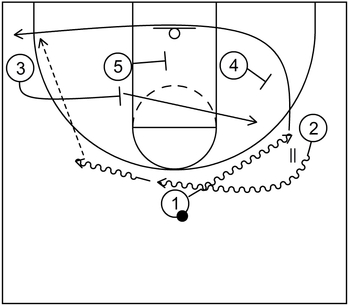
This is an example of a baseline runner set play derived from the Mississippi State women’s basketball team that could produce a jump shot for the team’s best shooter.
To start, 1 dribbles toward the right side wing to execute a dribble hand-off with 2.
Next, 2 dribbles toward the left slot area while 1 cuts across to the left side corner via the screens set by 4 and 5.
Additionally, 3 could set a quick brush screen if the defender that covers 1 decides to cheat over the top of the screen.
After that, 3 continues the cut across to the right side wing area. As that happens, 1 receives the ball from 2 and takes the open jump shot.
Elbow
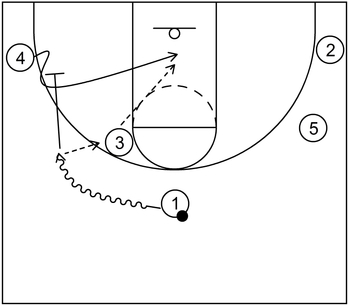
This is a quick hitting set derived from the Cleveland Cavaliers NBA team that could create a scoring opportunity near the basket.
To start, 1 dribbles toward the left side wing and after that, 3 receives the ball at the elbow. Next, 4 cuts to the basket via a wide pin down screen set by 1.
Following that, 4 receives the ball from 3 and scores near the basket.
Floppy
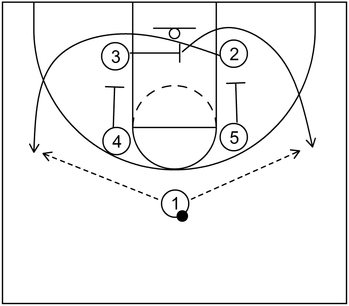
This is a quick hitting set derived from the Houston Cougars men’s basketball team that could create an open jump shot for the team’s best shooters.
To begin, 2 cuts to the left side wing via the cross screen set by 3 in addition to the pin down screen set by 4.
As that happens, 3 cuts to the right side wing via the pin down screen set by 5. Following that, 2 or 3 could receive the ball from 1 and take open jump shots.
High Low – Part 1
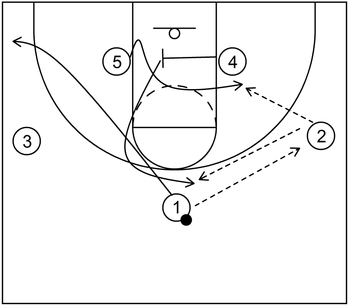
This is an example of a high low set that focuses on getting the ball to the team’s best low post player. To begin, 2 receives the ball from 1 and after that, 1 cuts through to the left side corner.
As that happens, 5 cuts to the right side low post block via the cross screen set by 4. Next, 4 cuts up to the top after setting the screen.
From that point, 5 could receive the ball from 2 and score with a low post move or 2 could reverse the ball to 4 at the top.
High Low – Part 2
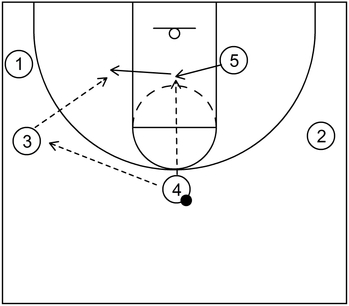
If 4 receives the ball, then 5 could duck into the lane. After that occurs, 5 could receive the ball from 4 to complete the high low action. From there, 5 could score near the basket with a low post move.
If 5 does not receive the ball, then 4 could reverse the ball to 3. Next, 5 could cut to the left side low post block and receive the ball from 3. Following that, 5 could score with a low post move.
Weave – Part 1
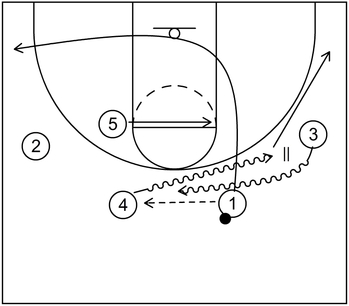
This is an example of a dribble weave derived from the Golden State Warriors with spread pick and roll action. To begin, 4 receives the ball from 1 who then cuts through to the left side corner.
Next, 4 dribbles toward the right side wing to execute the dribble hand-off with 3. After that, 3 dribbles back toward the top.
At the same time, 4 continues the cut to the right side corner while 5 cuts across from the left side elbow to the right side elbow.
Weave – Part 2
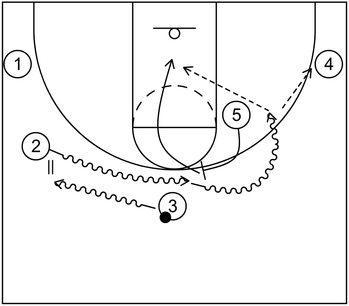
3 continues to dribble toward the left side wing to execute the dribble hand-off with 2. Following that, 2 dribbles back toward the top and then receives a ball screen from 5.
After setting the pick, 5 rolls to the basket and could receive the ball from 2 if open. Additionally, 2 could take the open jump shot or pass to 4 if open.